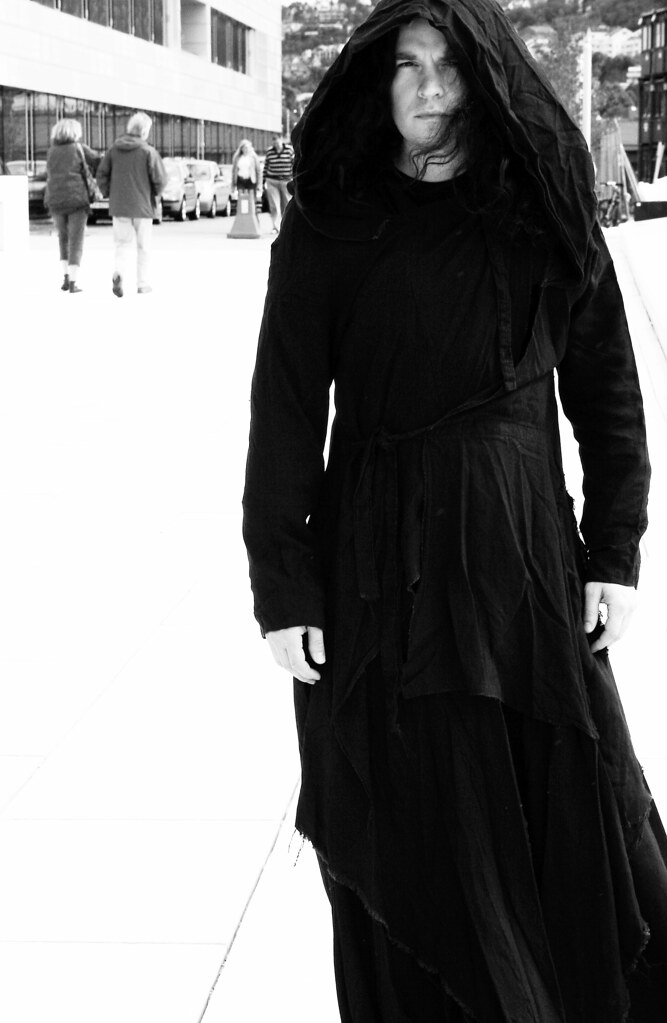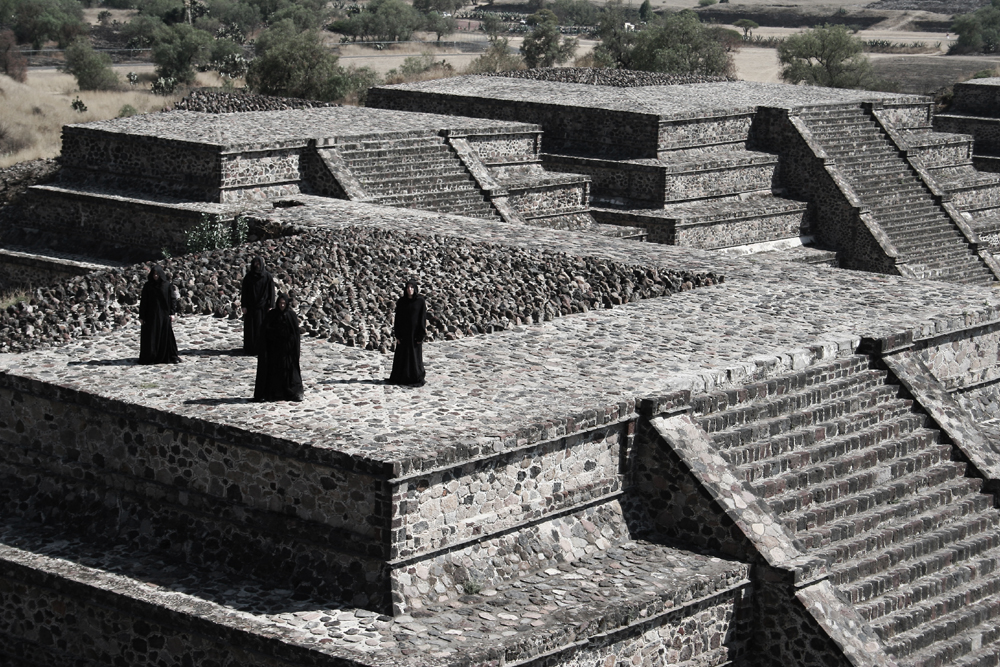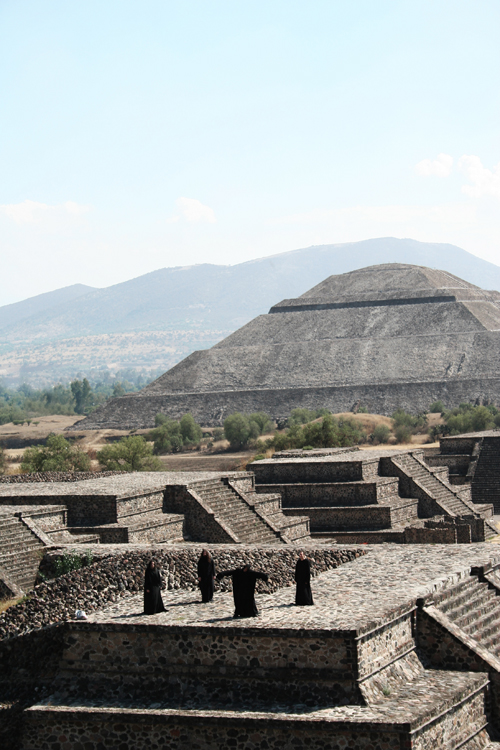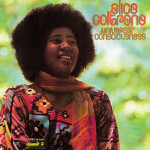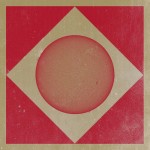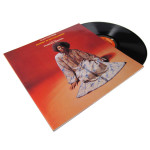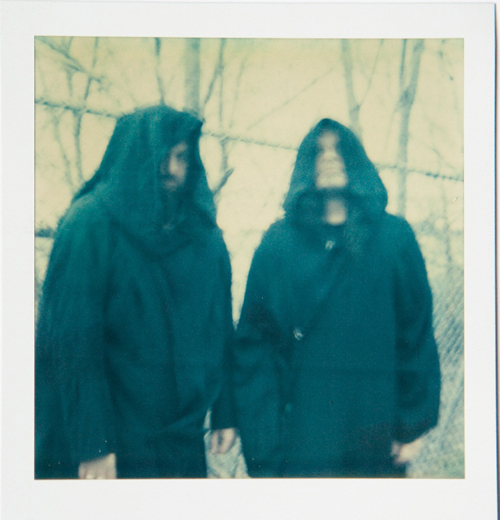
[Polaroid shot by Alexander Wagner; rest of photos by Jon Kristiansen & Giselle Vienne]
Interview by Andrew Parks
We usually skip listening sessions because they’re awkward, forced and rushed. With that in mind, the one for Sunn O)))‘s seventh studio album, the aptly-titled Monoliths & Dimensions, was a welcome diversion from everyday office affairs because it involved free beer and a studio grade stereo Jann Wenner couldn’t even afford. Not to mention a low profile appearance by a cooler-than-thou Jim Jarmusch, who hand-selected Sunn O))) and Boris for The Limits of Control soundtrack.
The verdict: best:listening session:ever, as the album’s four expansive acoustic v. electric battles washed over our eyes and ears, leaving us grasping for adjectives that’d describe a disc that channels everything from Alice Coltrane to death-metal and features such curveballs as a madcap conductor (the incomparable Eyvind Kang, who’s also worked with Animal Collective and Mr. Bungle), an otherworldly Viennese choir, and a trio of conch players. The following is from an s/t interview in New York’s Hell’s Kitchen area (how appropriate, right?) with Sunn’s core members, guitarists Stephen O’Malley and Greg Anderson. Expect a full-on feature with the pair, complete with streaming songs and a Sunn-invades-NY photo shoot, in our next digital issue, which drops in June…
“I played it for Peter from KTL and he said, ‘Oh I was expecting some brutal Ligetti stuff. But then it turns out to be this sort of Hollywood thing.'”
That listening session sure had a nice soundsystem.
Stephen O’Malley: It’s insane. Those are like $40,000 speakers because it’s a mastering studio, so it was even cool for us to go back and listen to it in that way. We went to the first session and couldn’t believe all the detail.
Achieving such detail must have taken a long time.
SOMA: This record took a year and a half, but that wasn’t all in the studio. We were probably in the studio for just two and a half months.
Greg Anderson: The thing was, we recorded in Seattle. I live in Los Angeles, Steve lives in Paris and [vocalist] Attila [Csihar] lives in Budapest. And the other guitarist that played a major part in the record, Oren Ambarchi, he lives in Australia. So getting us all together was a major challenge. Everything except for the choir on the second track (“Big Churchâ€)–which was done in Vienna–was recorded in Seattle.
Given the geography problem, were you both present for the entire session?
GA: I wasn’t able to be there for some of it because of family obligations, but the mixing involved the both of us the entire time.
SOMA: There were two weeks of initial mixing, one week and a half of acoustic overdubs, two days of choir stuff, and that was it for the tracking. Man, I’ve never done three weeks of tracking on any album.
What was the longest process previous to this then?
SOMA: A week maybe, which is long enough as is. The thing with Sunn, though, is that 70-percent of the time is just writing.
Did you do a lot of the writing separately since you live in different cities?
GA: Each guy might bring a different idea to break the ice or establish a foundational thing, but most of the writing was done during tracking in October of 2007, when Stephen and I were in the studio trading riffs and bouncing ideas off one another.
So when does someone like Oren–who’s played on a lot of your songs over the last couple years–come into the picture?
SOMA: More in the second stage. Oren doesn’t really have an ego about what he does. He played some of the stuff on guitar in the first stage with us, but Oren was mostly doing his beautiful thing over the second part. Especially with a track like “Aliceâ€; [his playing] inspired the structure of its second half.
He led it down a road where the mood changed a lot?
SOMA: Yeah, he put that blossom factor in. It was his take on the moody progression Greg and I put on the first part.
GA: As far as having three saturated guitars becoming this Big Riff, “Big Church†was the only one with Oren playing like that.
Dylan [Carlson, of Earth] played on that track too, right?
GA: Yeah, and there were some bass overdubs done.
SOMA: It’s hard to remember everything because so many layers happened between Dylan coming in, Steve Moore playing organ:That track sat around for nine months before an arrangement was written based off Dylan’s part, and the choir was added along with Attila and Jessika Kenney singing. That’s the other thing: Attila’s chants were before all of this, too. It’s like a 12-step process.
This seems like the kind of record a band would perform from the beginning to the end live.
SOMA: That’s not the spirit of the music, though. The present incarnation of the people involved has a lot to do with it. On that note, we’re trying to figure out how to do some special events with some of the acoustic stuff. We don’t want to restrict the band because of the elaborate nature of this record. We don’t want to shoot ourselves in the foot by saying, “Okay, now we need to bring 10 horn guys on the road with us,†and then spending 8,000 Euros on one gig.
GA: Some of the ideas from the record will be played live, like we want to continue to work with Attila. Also Steve Moore, on trombone and keyboards.
Was there an overall concept guiding this album, either musically or lyrically?
GA: Nothing concrete, really. That’s the incredible thing to me about the record–it developed and unfolded naturally. This is the longest it took us to take a record:
SOMA: It was stressful. At some points, we didn’t know what was going to happen after putting all of this work into it. We couldn’t even see the halfway point:But as things gelled together at the end, it became some amazing and pleasurable.
It must have felt like a big payoff.
SOMA: Not a payoff; you just see the completed form after months and months of sculpting. I mean, Burning Witch (the duo’s previous band) recorded [Towers…] in three days and mixed with Steve Albini, and it’s fucking amazing. That’s a different category of music, obviously, but looking back at all of your projects over the years:You know, I worked in advertising for a while in New York and some of the longest projects were 60 hours a week, for three months. That was about a third of this [effort wise], because it wasn’t as passionate.
“Alice†ends the album on a positive note, surprisingly. Was it originally going to be much darker?
SOMA: I wouldn’t think about it in a negative term like [‘being darker’]. It’s a developing piece of music:
The horns and guitars seem to be battling at one point, with the horns actually winning out in the end.
SOMA: The idea is that it’s a duel, a transformation of sound and timbre through a series of instruments. That was done in January of last year–that and the stuff for “Aghartha.†October was the amplified tracking session and January was the acoustic tracking session. Then there was Vienna in August and the mixing sessions. It was a lot of flights.
Sounds like a nightmare.
SOMA: It’s not a nightmare, man.
GA: It’s a daymare. [Laughs] That’s the name of our label in Japan.
SOMA: It’s not a nightmare; it’s a proper extended production. Can you imagine what it’s like making a film?
You mentioned Daymare. Sunn reissued a ton of old records through that label last year. Did you listen to some stuff for the first time in years?
SOMA: No, it was more like, “Pull another one out of the archives. What do we have here? ‘2003.’ Okay, there we go: Live White.
I find that hard to believe. You seem to put a lot of time into the presentation of your records.
SOMA: Of course we do.
GA: To comment on your question, I actually don’t listen to a lot of our music, unless it’s a new recording.
SOMA: I barely do either, but when I do, I find something new to like about them. Like I listened to the Altar album for the first time in a year recently. Some of the songs were licensed for that Jarmusch soundtrack, so we had to make edits. One of them, “Bloodswamp,†was like 17 minutes.
GA: “N.L.T.†is going to run in its full form, though.
SOMA: Right. So I was listening to the edits against the full album and thought, “This is great.†I’m not tooting our own horn; at first, I loved the record, but I thought it wasn’t heavy so much as a rock ‘n’ roll record.
GA: It’s not a rock ‘n’ roll record, bro! [Laughs] Just because there’s some drums on it?
SOMA: Nah, that’s just my memory of it, dude. But I listened to it again and thought, “This is fucking insane!â€
GA: The ambition of that record set us up for this one to some degree.
SOMA: Yeah, it gave us confidence and hope in what’s possible.
GA: If we can pull that off, we can finish this record, you know?
SOMA: I remember being in Barcelona after playing this festival–having some tapas or something–and [longtime engineer] Randall [Dunn] was like [in the nerdiest voice possible], “I’ve been talking about Eyvind Kang for four years. Blah, blah, blah.â€
GA: We were already a fan of his music, like this record he made with his wife, Jessika, who’s also on the record. It’s called Æstuarium. It was our intro music on one tour, as we were setting up our amps.
SOMA: It’s her singing and him on the viola–a study of intonations. Amazing stuff. The engineers of this record put it out. It’s a great record, but they only put 500 copies of it.
So was Eyvind present for most of the process?
SOMA: In the acoustic session, yeah. He was the conductor and would talk to us about a lot of ideas, so that nothing would sound like ‘a guitar track with strings tossed on top of it.’ It’s all integrated well.
What were the first couple days of the acoustic session like? Obviously, having a conductor around was a new experience for you.
SOMA: Figuring out his process was interesting, for sure, in the same way it has been with Attila. The first sessions were at Randall’s studio, the basement of his house. Which was fun, like, “Okay, I have to go outside now and carry a harp down these stairs.†I was like a roadie for a harp player:
GA: You had to be careful, too, because it was muddy. I slipped several times.
SOMA: While carrying a $40,000 harp!
To be honest, the harp was one of my favorite parts [in “Aliceâ€].
SOMA: Not only is it a harp; it’s a harp and flute duo.
GA: Well, the track is called “Alice,†and Alice Coltrane was an amazing harp player.
Maybe so, but you certainly don’t expect that in a Sunn song.
SOMA: True. You know what I found about that? I played it for Peter from KTL and he said, “Oh I was expecting some brutal Ligeti stuff. (György Sándor Ligeti is best known for his work in Stanley Kubrick’s films.) But then it turns out to be this sort of Hollywood thing.†I was like, “Man, do you know who Alice Coltrane is?†And he’s like, “I don’t know what you’re talking about.†That said, people who know Alice Coltrane and heard it were immediately like, “I got it. It’s spiritual music–that kind of vibe.†It’s not meant to be academic, you know?
So let’s say a Sunn fan hears this song and really digs it. What’s a good Alice Coltrane record for them to check out right away?
GA: Universal Consciousness.
SOMA: Journey in Satchidananda. I personally like her earliest stuff–the records on Impulse!. I also love the stuff she played with [John] Coltrane. Live In Japan, man, that stuff’s insane.
GA: That one album she did with her son, Ravi, is awesome too. [2004’s] Translinear Light. A couple tracks on there just floor me.
SOMA: I was curious to listen to that and also be into her early stuff. Hearing the production difference:
GA: Yeah, the newer stuff is a lot slicker.
SOMA: You have to listen to the music and ignore that.
GA: That’s the thing about jazz from the ‘80s and ‘90s: it’s just so slick.
SOMA: You can hear this development as they started using the trendiest gear:
GA: There’s a certain warmth to recordings from the ‘50s, ‘60s and ‘70s that’s missing from everything after that.
That’s the unfortunate thing, though: a lot of kids in their twenties view jazz as this sterile form of music.
GA: But you know what, man? It’s like any genre–you gotta dig. And once you dig, you’ll be fucking stoked.
Tell me a little bit about the first track on the album. It sounds like the end of the world to me:
SOMA: “Aghartha†was totally focused around Attila’s vocals. We soloed his vocal take after he’d done it and turned on the sub in the control room. It was crazy! We were like, “This be the best performance from Attila on any record. Maybe not the charisma of his best material, but in terms of the actual sound.â€
It certainly sounds dramatic. Was that in one take?
SOMA: Yep, that was his first take.
And he chose the lyrics?
GA: Oh yeah, he wrote that. Most definitely.
Did he spend a lot of time figuring out the intonations and everything then?
SOMA: He did. He actually presented a lot of his concepts, like, “I want to do a track about Aghartha. You know, the hollow earth thing?†It’s basically this shell with continents inside of it–a black sun inside the earth. That was his idea.
So what do you say to something like that? Go run with it?
[Laughs]
SOMA: Yeah, “Go run with that!â€
GA: “I’m giving you the green light, bro!â€
